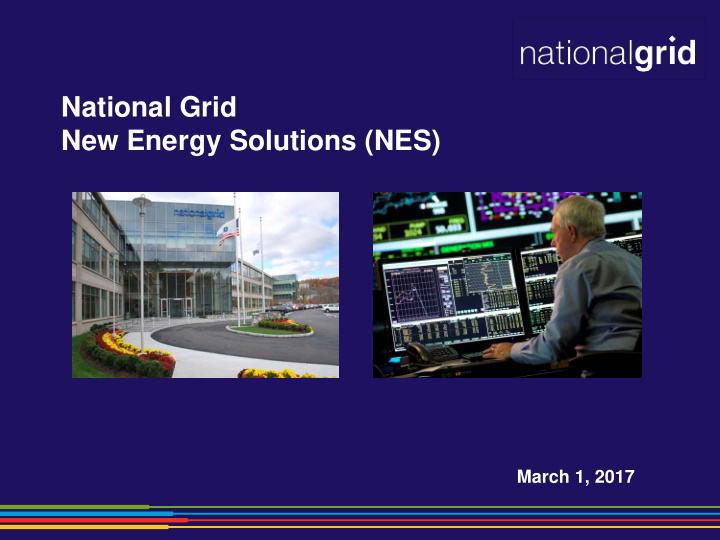



National Grid New Energy Solutions (NES) March 1, 2017
National Grid US 3.3 m electric and 3.6 m gas customers 13,672 employees ~$9B rate base +$2B capital invest. 2
New Energy Solutions Add an image here Our Purpose New Energy Solutions is an agile team focused on Establish plans and strategies to developing and launching modernize our electric and gas innovative solutions and grids technologies that unlock Expand the role of the utility value for National Grid’s customers and communities Drive growth and customer value and accelerate progress Bring commercial focus to a set of towards a sustainable future. technology and regulatory issues 3
The energy transformation is creating challenges and opportunities … which drive the need Our shifting energy … creates challenges for flexibility market … and opportunities … Decarbonization Storage, and other flexibility tools, can Generation migrates from large Price volatility increases help: central plant to smaller o Renewables export at lower intermittent & flexible power prices renewable assets o Expensive peaking Improve asset generation plugs the gap performance & Demand and supply profiles utilization Networks congested during shift, causing peaks at different peak periods times (duck curve) Asset utilization reduced Support system Decentralization balancing & ancillary Forecasting becomes services Generation units decrease in increasingly challenging size and move downstream, Real time balancing & closer to consumption operations are difficult Reduce wholesale energy and capacity New technology costs Rise of electricity assets like storage and new digital platforms 4
Modernizing the grid is foundational to achieve all environmental and efficiency objectives This approach is the same one that we’ve used across our services area: AMF Deployment Grid Modernization Cybersecurity DSP Development Key considerations Also market factors when planning play a role Customer needs and wants Technology advancements Regulatory feedback and DER adoption levels guidance Policy and Environmental Stakeholder feedback targets and goals Learnings from previous pilots 5
However the challenge is not just in making the investments and the technology Partnerships and new business models will play a big role in the journey Software as a Service Sharing of licenses Surge Price Unutilized capacity 6
A lot of things coming together and we need to make sure that we’re leverage all assets EVs Utility-Scale Solar PV Smart Meters Utility-Scale GRID of Wind Utility-Scale THINGS Battery Storage Energy Efficiency Solar Rooftops (200 MW) Demand 50 Billion Things Response Non-Intermittent Therms/year Generation Energy Efficiency DSP 7
NY DSP Demonstration What are we doing Creating market opportunities and pricing models for investment in DER/DR capabilities that will lead to: o Optimized electric system distribution o Maximized customer energy assets o Motivating ROI 3 phase approach o Development of valuation model to unlock potential assets o Development of DSP platform o Integration of Points of Control (POCs) into the DSP Why Test functional, operational and monetary benefits to the local electric distribution system and the DSP that flow from the node based on the capabilities of customer-owned DER. Test customers’ willingness to participate Determine if prevailing nodal values would provide sufficient financial motivation for customer investment in DER. 8
Electric vehicles will play a big in the energy space in the future Customer Outreach and Education Targeted Charging Station Expansion Looking to enable the entire chain for EV infrastructure Utility Distribution Customer Site EV Supply Infrastructure Infrastructure Equipment (EVSE) 9
Utility scale solar and other DER systems generate value to customers National Grid has been active in the solar market since 2009… Received approval from Department of Public Utilities (DPU) in 2009 to own and operate Solar We have completed two solar deployments already (23 sites in total and 21 MW) in MA Building upon learnings from PH I/II, the filing includes plans to implement new technology: o Integrated inverters o Panel positioning for optimized output o Canopy solar o Sun tracking systems 10
Business case for storage often requires stacking benefits from multiple applications Illustrative Example of Cost-Benefit Analysis for IOU Use Case Traditional T&D upgrade deferral may not be cost effective; however, stacking other benefits may make the business case positive Control systems to support the integration of storage will be critical to achieve positive economics Source: DOER State of Charge Report, 2016 11
National Grid has a pipeline of regulated storage projects in the U.S. Project Location Size Status Worcester and [2x] 500kW, Commission 2017, DOE ARRA Demo Everett, MA 6hr end YE 2018 MA Solar phase II Shirley, MA 500kW, 2 hr. Commission 2017 MA Solar phase III MA 7 MW Approved NY REV Demo: Neighborhood Solar, Buffalo, NY TBD Proposed Fruitbelt GridMod filed; GridMod Renewable-Integrated MA 1 MW, 6 hr. pending MA DPU Distribution Storage Demo decision GridMod filed; GridMod High Density Community [100x] 25 kw, 4 MA pending MA DPU Storage Demo hr. decision 12
“Th The e elect ctric l ligh ght d did not come f e from c conti ntinu nuous s impr provem ement o ent of candl dles” s” (Oren Harari)
Questions
Recommend
More recommend